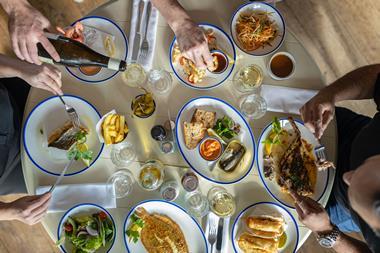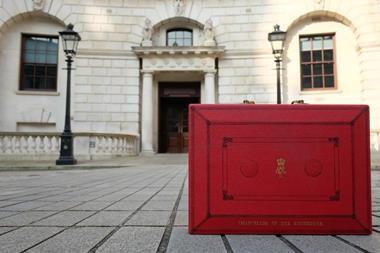When Emma Reynolds began a noodle business with her flatmate, she never expected the potential to be realised so quickly and in such an impressive manner. Mel Flaherty catches up with the former microbiology student
What have microbiology and noodles got in common? The answer is not the punchline to a joke from a cheap Christmas cracker, it is Emma Reynolds.
Reynolds, co-founder of Tonkotsu, which comprises seven Tonkotsu ramen restaurants, plus the two Tsuru sushi and katsu curry bars and, most recently, Anzu, the upmarket Japanese restaurant in St James’s, London, had worked in restaurants from the age of 16. She knew she wanted her career to be in the industry, but she also wanted to do “a proper degree” first. So, microbiology it was: “It was really interesting, but I have not really used it since. I still read the New Scientist every week though.”
She agrees, however, that her studies may have made her more analytical than usual in her approach to the business.
Unlocking Japanese food
Some 12 years ago, after a post-university spell working in PR and marketing, Rey-nolds moved to London where she met her friend, flatmate for a while, and now long-term business partner, Ken Yamada. Yamada came from a chef background and his parents worked in hospitality in his native Japan. Reynolds was working for Jollof Pot, a London-based catering firm specialising in modern Ghanaian food. The pair discussed plans for their own restaurant and when they got together with another friend, barrister John Zimmern (still involved on the financial side and on the board, but now as a silent partner), they started drilling down to exactly what their niche could be.
“I spent a lot of time in the British Library doing market research. Asian food, then more specifically Japanese, made sense, not just because of Ken’s experience but also because all the studies showed it was the fastest-growing food category in the UK.
“There were Japanese restaurants but they were not very accessible as they were either very high end or, if you took it down to fast casual, they were very much for Japanese people.”
The trio refined their idea to accessible but prepared from scratch and got the money together themselves to get it off the ground. Reynolds recalls that then, as remains the case now, getting a site was the hardest part. Fortuitously, a friend of a friend introduced them to property firm Land Securities who took a punt and allowed them to open their first site on Canvey Street, behind the Tate Modern gallery in London.
It was successful enough to allow them to open a second and third Tsuru, but the brand’s commitment to quality, which was essential to differentiate it in what was then a burgeoning sector, meant that it, ultimately, did not have legs.
“At that time, itsu came along and commoditised the lunchtime sushi market and now, of course, you can get sushi in supermarkets too; so we were a bit more expensive and we soon recognised that Tsuru was not really expandable.”
Successful trials
Undeterred, Reynolds and her co-founders talked about other opportunities in the Japanese dining market and realised that at that point no one in the UK was really focusing on ramen.
“It was crazy really, because a quarter of all meals eaten out of the home in Japan are ramen. It is cheap, easy, quick and nourishing,” she says, readily reeling off the stats.
To test out their hunch that they could do something scalable based on noodles, Reynolds and Yamada spent several Friday evenings in their flat taking delivery of 50 kilos of pork and boiling it up for hours to make stock (while drinking beer, she adds).
They did a series of 10 Saturday pop-up events at Tsuru, which ordinarily remained closed on Saturdays, advertising to their existing customers via their website and Twitter. Tickets were £10 for a bowl of noodles and a bottle of Japanese beer and for the first event, for 30 people, they sold out in five minutes. For the last event of the 10, they sold 120 tickets (Reynolds said if they had the resources it could have sold many more) and served ramen and beer from 5pm and stayed partying with their customers until 2am.
Based on the success of these trials, in 2012 the company put together a ramen-based business plan. In 2013, the firm secured a site on Dean Street, Soho (being on three floors and, therefore, requiring more staff, it had been rejected by the larger operators), where it opened the first Tonkotsu. It took off right away, with customers queuing to get in. In October that year, the restaurant won the Observer Food Monthly Awards prize for Best Cheap Eats and its popularity soared. Tonkotsu East, in Dunston Street, Hackney, soon followed, and then another restaurant slightly further east in Mare Street. The sit-down concept also opened up opportunities to develop the range of drinks, especially Japanese beers, and gave more flexibility (the Mare Street restaurant, for example, has an extensive range of Japanese whiskies, and the brand is working on a number of collaborations for guest ramen dishes with various well-known chefs). When the chance arose to take a spot within Selfridges’ food hall, Reynolds and the team grabbed it and now the 15-seat outlet is, per seat, the group’s busiest (although Soho, being larger, does more sales, averaging in the mid-£20,000s each week). In September, Tonkotsu opened its first unit outside London, at Selfridges in Birmingham.
Right structure in place
Including the Selfridges outlets, there are now a total of seven Tonkotsus, one of which used to be the first Tsuru. Two Tsuru outlets remain and while there are no plans to convert them, the focus for expansion is very much on Tonkotsu.
In November, the group opened its first premium restaurant, Anzu. Although it is already trading very well, Reynolds says the group views it as a one-off opportunity for Yamada to exercise his desire to create dishes using more expensive ingredients.
The Tonkotsu back story is fascinating and has developed it into a business turning over £6m this year, with 75% of that from food sales, and employing 120 people. It is now in a position where its future is of even greater interest.
To help Tonkotsu achieve its potential, the group has been busy getting its internal structure right. In the summer, the company appointed Stephen Evans, the former development director of Gourmet Burger Kitchen, as operations director. He has since taken on the mantle of managing director, pressing ahead with initiatives
like the successful introduction of the UberEATS delivery service to three of the sites and putting his experience in site finding to use, allowing Yamada and Reynolds to focus on the newest restaurants.
Other recent appointments, mainly internal promotions, have been an operations manager, a head of drinks and an executive chef. The company is also on the brink of appointing its first finance director.
“It is all very grown up,” Reynolds laughs. “We didn’t start out thinking we would have x-number of restaurants in so many years, we just said ‘we’ll see how it goes’.
“It has helped us grow in a good way and to recruit the right kind of people and develop a loyal customer base, but we can’t go to the next phase with that attitude. We need structure with focus and targets.”
Not that this concerns her, Reynolds is looking forward to moving up to this level.
The first quarter of the year will see a rebranding exercise for the group to give it a more consistent image while conveying Tonkotsu as “an accessible but not too mainstream brand – we don’t want to over brand it and lose the independent feel.”
The aim is then to open a further three Tonkotsus by the end of 2017.
Reynolds says she has her eye on a couple of sites in south London and it is likely all three will be within the capital “unless something amazing comes up”. She adds, however, that in 2018, when the new head office team is bedded down, the group will more actively seek other locations, ideally within an hour of London, in urban centres such as Brighton and Cambridge.
Self-funding plans
The Tonkotsu model has proven itself flexible and able to work in unusual configurations such as the long thin counter with 20 seats at Notting Hill to the three-storey Soho branch, but the ideal would be a 50 to 60-seat restaurant, which Reynolds recognises is the ideal for most of the sector. It takes about £250,000, excluding the premium, to get a site running and she says payback is comfortably within the magic three-year period favoured by investors.
The business has some debt funding to realise its ambitions for early next year, then hopes to be self-funding. “Casual conversations” are under way with interested parties with regards to external funding, which Reynolds anticipates will turn much more serious come mid to late 2017.
Right from the beginning, Reynolds’ and Yamada’s philosophy has been to create restaurants that they would like to eat in with good quality, reasonably-priced food. It’s not rocket science. It’s not microbiology either.
■ Mel Flaherty is a freelance journalist specialising in the hospitality sector










































